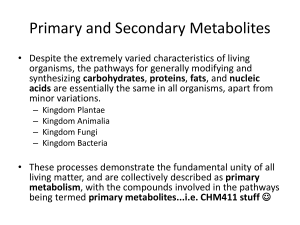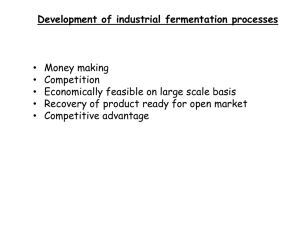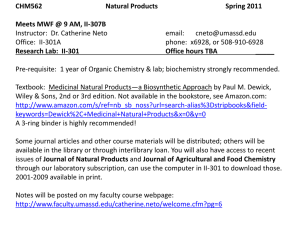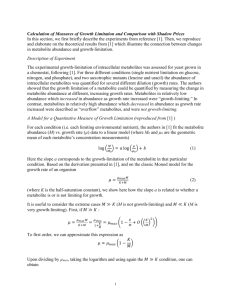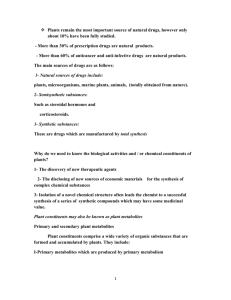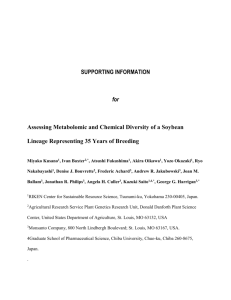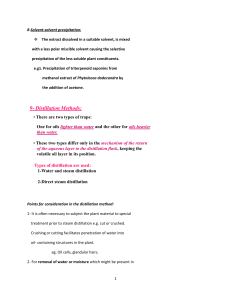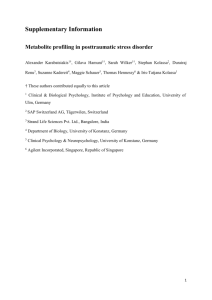2. Microbial Growth Kinetics
advertisement
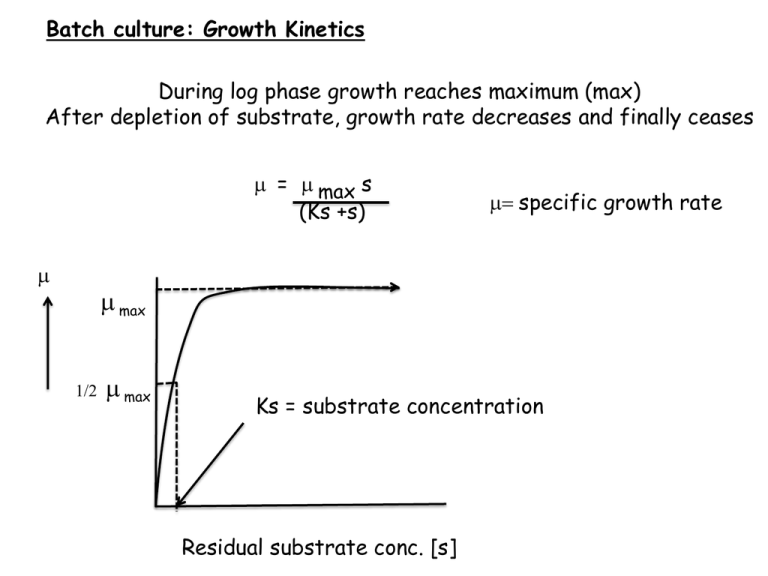
Batch culture: Growth Kinetics During log phase growth reaches maximum (max) After depletion of substrate, growth rate decreases and finally ceases m = m max s (Ks +s) m m= specific growth rate m max 1/2 m max Ks = substrate concentration Residual substrate conc. [s] As growth increases biomass increases: during log phase dx = mx dt 1 dx. 1 dt x x = cell conc (biomass) (mg/m3) t = incubation time (h) m = specific growth rate (h-1) =m dx dt m =slope x Beginning of log phase t=0 biomass X0 On integration of equation 1 ∫dx x = ∫ mx Loge X = mt + K (integration constant) 2 when t=0 Log X0 = K put this value in equation 2 loge X = mt + loge X0 Loge X –loge X0 = mt ln X X0 = mt ln X . 1 = td X0 m 3 When t = td X = 2X0 Then ln X . 1 = td X0 m ln 2X0 . 1 X0 m ln 2 m = td = td 0.693 = td m m = 0.693 td m is inversely proportional to td If td is high m is low and vice versa X0 cells inoculated at time t0 X cells at time t dx = mx dt Can be written as equation 3 ln X X0 = mt ln X –ln X0 = mt Converting natural log (log10 X –log10 X0) 2.303 = mt (log10 X –log10 X0) 2.303 = tt-t0 m (log10 X –log10 X0) 2.303 = m tt-t0 m = m max s (Ks +s) m= specific growth rate m m max 1/2 m max Ks = substrate concentration Residual substrate conc. [s] Continuous culture Continuous enrichment culture Volume added should be volume removed V working volume of the fermenter: m3 F rate of flow in and out m3h-1 Dilution rate = F/V F = DV (h-1) Basic principles of continuous culture is controlled by Dilution rate Rate of limiting substrate conc not m Output of biomass in continuous culture Rate at which medium passes out of the outflow (flow rate F) conc of biomass in the outflow (i.e. X) Output = FX Since F= DV Output = DVX Productivity that is output per unit volume prod = DVX prod = DX V Continuous enrichment culture MO isolated by this method survive fermentation much better than batch isolated MO Main problem: Washout of the inoculum Solution: Isolate MO in a batch culture using 20% inoculum, as soon as growth is observed transfer to fresh medium so that stabilization and subsequent purification is performed in a continuous culture Periodic inoculation of soil or sewage to the culture will ensure as the source of potential isolates; dominants must be resistant to contamination. Measurement of Microbial Growth Wet weight measurement Dry weight measurement: 10-20% of wet weight Absorbance: spectrophotometer Total cell count: haemocytometer Viable cell count: dilution plate method Development of industrial fermentation processes • • • • • Money making Competition Economically feasible on large scale basis Recovery of product ready for open market Competitive advantage Criteria for being important in choice of organism 1. Nutritional characteristics of the organism when grown on a cheap medium 2. Optimum temp of the organism 3. Reaction of the organism with the equipment and suitability for the type of process 4. Stability of the organism and its amenability for genetic manipulation 5. Productivity of the organism i.e. ability to convert substrate into product per unit time 6. Ease of product recovery from the culture What are the R&D approaches for finding of a MO of economic value, and large scale fermentation process? Micro-organism Stock culture collections Source Screening Primary screening Secondary screening Environment (soil) Primary screening • Highly selective procedures for detection and isolation of MO of interest • Few steps will allow elimination of valueless MO • Eg. Crowded plate technique for Ab screening, serial dilution, acid base indicator dyes, CaCO3, sole source carbon or nitrogen, enrichment tech • Does not give too much information on detail ability of the microorganisms • May yield only a few organisms and few of them may have commercial value Common techniques I. 1. 2. 3. 4. 5. 6. Direct wipe or sponge of the soil Soil dilution (10-1 to 10-10) Gradient plate method (streak, pour) Aerosol dilution Flotation Centrifugation II. Enrichment, screening for metabolites or microbial products III. Unusual environments Secondary screening • Sorting of MO that have real commercial value for industrial processes and discarding those which lack potential • Conducted on agar plates (not sensitive), small flasks or small fermentors (more sensitive) containing liquid media or combination of these approaches. • Liquid culture provide better info on nutritional, physical and production responses. • Can be qualitative or quantitative Preservation of Industrially important MO • Viable and Free from contamination • Stored in such a way so as to eliminate genetic change and retain viability • Viable by repeated sub-culture (avoid mutations by keeping stocks and strain degeneration and contaminations) Preservation of Industrially important MO 1. Storage at reduced temperature a. Agar slopes at 50C or in -200C freezer: viable for 6 months b. Liquid nitrogen (-1960C): problems of refilling, advantages 2. Storage at dehydrated form a. Dried cultures b. Lyophillization Quality control of preserved stock: batch system, single colony, typical pattern, large number, purity, viability and productity If sample fails entire batch is destroyed MICROBIAL METABOLIC PRODUCTS OR METABOLITES • Wide range of products having commercial value Algae SCP Bacteria acetic acid bactracin gramicidin endotoxin glutamic acid vitamin B12 Actinomycetes antibiotics (tetracycline, streptomycin, neomycin, rifamycin, gentamycin) Fungi citric acid, amylase, cellulase, SCP, lipase, pencillin, ethanol, wine, steroids, gibberllin Types of Low molecular weight compounds by MO SUBSTRATE Primary metabolites Secondary metabolites Antibiotics Essential metabolites Amino acids Nucleosides vitamins Ethanol, acetone, lactic acid, butanol Steroids Amino acids Alkaloids Gibberlins Pigments Metabolic end products Bioconversions Ascorbic acid Primary metabolism Secondary metabolism Idiophase Trophophase Concentration Cell Mass Limiting nutrient Secondary metabolite Time PRIMARY METABOLITES Formed in trophophase (log phase) Balanced growth of MO Occurs when all nutrients are provided in the medium Its is essential for survival and existence of the organism and reproduction Cells have optimum concentration of all macromolecules (proteins, DNA, RNA etc.) Exponential growth PRIMARY METABOLITES 1. Primary essential metabolites: • • • • Produced in adequate amount to sustain cell growth Vitamins, amino acids, nucleosides These are not overproduced, wasteful Overproduction is genetically manipulated 2. Primary essential end products: • • • Normal end products of fermentation process of primary metabolism Not have a significant function in MO but have industrial applications Ethanol, acetone, lactic acid, CO2 LIMITATIONS: growth rate slows down due to limited supply of any other nutrient. Metabolism does not stop but product formation stops. OVERPRODUCTION OF PRIMARY METABOLITES Manipulation of feedback inhibition • Auxotrophic mutants having a block in steps of a biosynthetic pathway for the formation of primary metabolite (intermediate not final end prod). End product formation is blocked and no feedback inhibition • Mutant MO with defective metabolite production Unbranched pathway intermediate A ---- > B ----> C -----> D ------> E Starting substrate Final end prod Blocked reaction Required metabolite SECONDARY METABOLITES • Characterized by secondary metabolism and secondary metabolites (idolites) • Produced in abundance, industrially important Characteristics: 1. 2. 3. 4. Specifically produced Non essential for growth Influenced by environmental factors Some produce a group of compds eg a strain of Streptomyces produced 35 anthracyclines 5. Biosynthetic pathways are not established 6. Regulation of formation is more complex Functions: 1. May or may not contribute for existence or survival of the MO OVERPRODUCTION OF SECONDARY METABOLITES More complex Several genes are involved eg may be 300 to 2000 genes Regulatory systems are more complex Some regulatory mechanisms 1. Induction: eg tryptophan for ergot production etc 2. End product regulation: some metabolite inhibit their own biosysnthesis 3. Catabolite regulation: key enzyme inactivated, inhibited or repressed eg. Glucose can inhibit several antibiotics ammonia as inhibitor for antibiotic prod. 4. Phosphate regulation: Pi for growth and multiplication in pro and eukaryotes. Increase in pi conc can increase secondary metabolites but excess harmful 5. Autoregulation: self regulation mechanism for production like hormones BIOCONVERSIONS OR BIOTRANSFORMATIONS Used for chemical transformation of unusual substrates for desired prods Conversion of ethanol to acetic acid, sorbitol to sorbose, synthesis of steroid hormones and certain amino acids Structurally related compounds in one or few enzymatic reactions Can use resting cells, spores or even killed cells. Mixed cultures can also be used, use of immobilized cells at low cost METABOLIC PATHWAYS IN MICRO-ORGANISMS 1. PROVIDES PRECURSORS FOR THE CELL COMPONENTS 2. ENERGY FOR ENERGY REQUIRING PROCESSES Unique feature of heterotrophic MO Secrete extracellular enzymes METABOLIC PATHWAYS IN MICRO-ORGANISMS Sugars to Pyruvate The ways in which microorganisms degrade sugars to pyruvate and similar intermediates are introduced by focusing on only three routes: (1) Glycolysis (Embden Meyerhof Pathway) (2) The pentose phosphate pathway, (3) The Entner-Doudoroff pathway (1) Glycolysis: glucose to pyruvate 6-carbon phase oxidation phase energy harvest phase Glucose KDPG pathway Glucose 6 Phosphate Pyruvic acid Pentose phosphate pathway Entner-Doudoroff pathway Glucose ATP Glucose-6-P NADPH 6-phosphogluconate instead of Fructose 6-P 2-keto-3-deoxy-6-phosphogluconate (KDPG) Pyruvate glyceraldehyde-3-P Meyerhof pathway 2ATP Pyruvate Embden-
